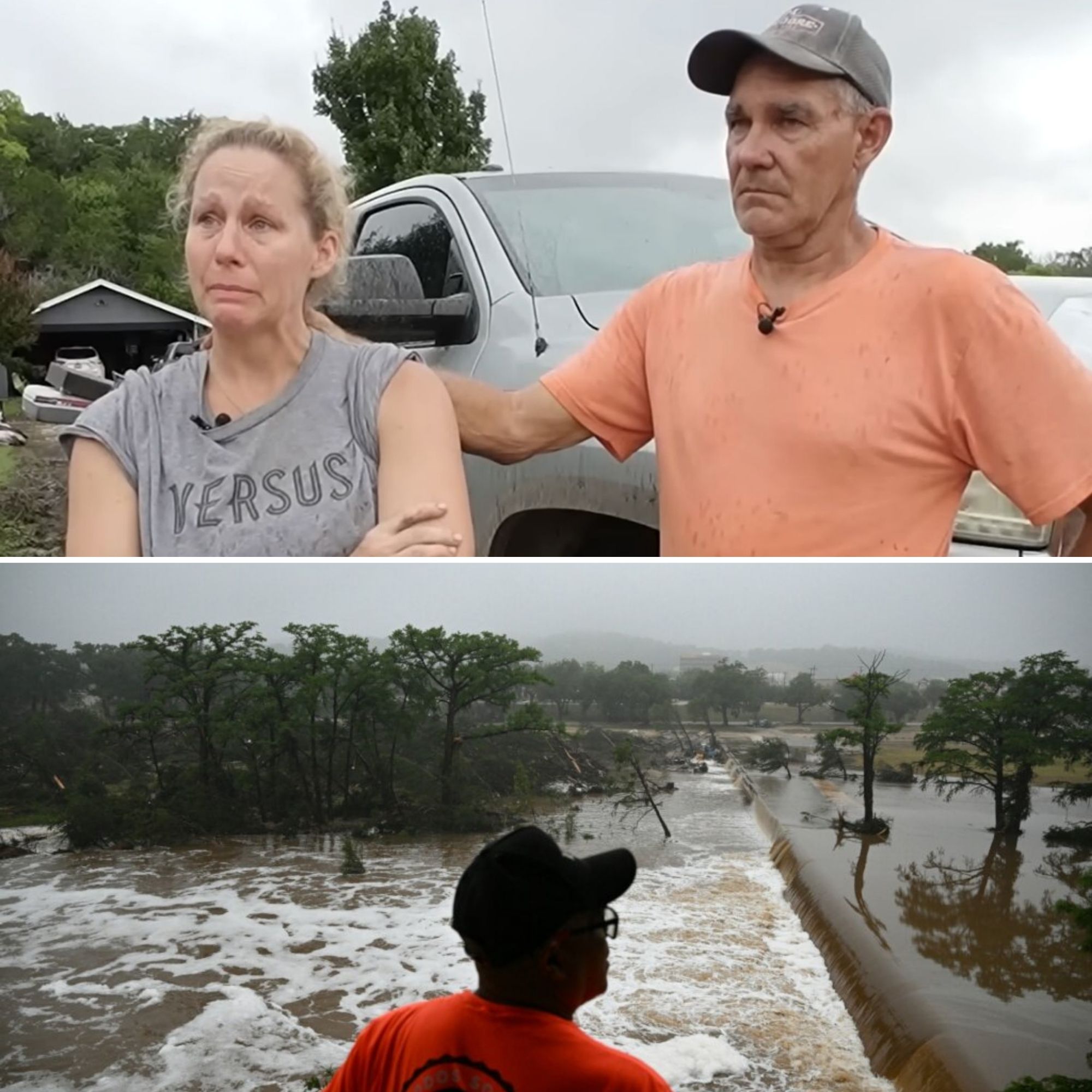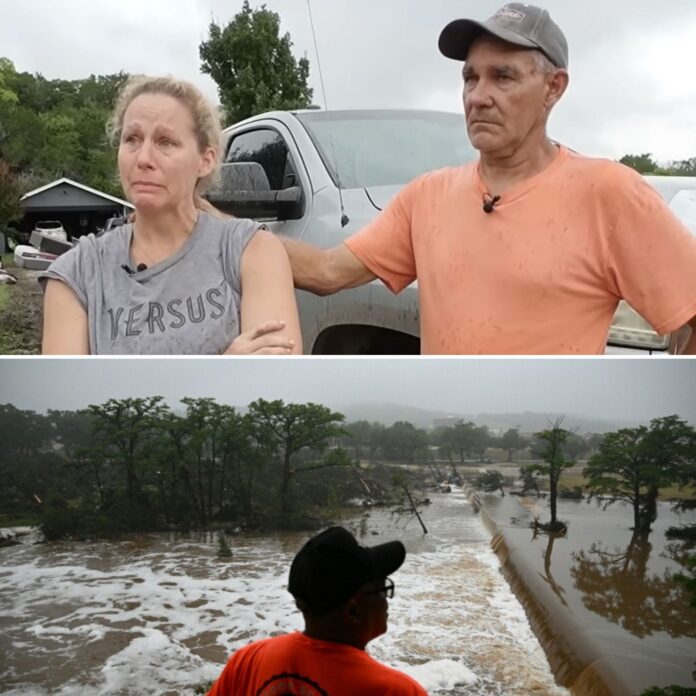🌊 “I saw children floating, begging for help we couldn’t reach…” One survivor’s haunting words from the Texas nightmare that claimed hundreds. What turned a holiday into hell? The river didn’t wait… Discover the shocking truth that left a nation stunned.

The Texas Hill Country, with its rolling landscapes, winding rivers, and idyllic summer camps, has long been a haven for families seeking respite from the sweltering heat. But on July 4, 2025, what should have been a day of celebration turned into one of the deadliest natural disasters in recent U.S. history. Torrential rains unleashed a catastrophic flash flood along the Guadalupe River, particularly devastating Kerr County and surrounding areas. Over 135 lives were lost, many of them children attending summer camps, and the region was left reeling from the sheer speed and ferocity of the waters. As one survivor poignantly recounted, “The river was faster than the help,” encapsulating the helplessness felt by those caught in the deluge. This article delves into the events leading up to the flood, the survivors’ gripping accounts, the response efforts, and the broader implications for flood-prone regions like the Texas Hill Country.
The Build-Up: A Perfect Storm in the Making
The Texas Hill Country is no stranger to flash floods. Its geology—characterized by thin soils over limestone bedrock—means that heavy rainfall has little opportunity to seep into the ground, instead channeling rapidly into rivers and creeks. Climatologists have long warned that this area is one of the deadliest in the U.S. for such events, with historical precedents like the 1978 Canyon Lake flood and the 2015 Memorial Day deluge serving as grim reminders. In July 2025, a combination of factors amplified the risk. A stalled low-pressure system over Central Texas dumped nearly two feet of rain in some spots within hours, overwhelming the Guadalupe River basin.
Meteorological data from the National Weather Service indicated that the storm began intensifying late on July 3, with warnings issued for potential flooding. However, the holiday weekend may have dulled vigilance. Summer camps along the river, popular for their scenic locations, were packed with children and staff enjoying Independence Day activities. In Kerr County alone, camps like those near Comfort and Center Point became ground zero. By the early hours of July 4, the Guadalupe River rose an astonishing 26 feet in just 45 minutes—a rate that experts described as unprecedented. This rapid escalation caught many off guard, turning calm waters into a raging torrent that swept away cabins, vehicles, and lives.
The timeline of the disaster, as reconstructed by investigators, reveals a narrow window for escape. At around 2 a.m., initial reports of rising waters trickled in via 911 calls from Kendall County, adjacent to Kerr. Dispatchers heard frantic pleas: “Oh my god, there’s people screaming in the river.” By dawn, the flood had peaked, with water levels submerging entire communities. Aerial imagery captured by NOAA later showed widespread devastation: homes reduced to rubble, bridges collapsed, and debris strewn across miles of riverbank. Nearly every major river basin in South Central Texas experienced flooding in the days that followed, exacerbating the crisis.
Survivors’ Stories: Echoes of Terror and Resilience
The human cost of the flood is best understood through the voices of those who lived through it. Survivors’ accounts paint a picture of chaos, loss, and improbable heroism. One woman from Center Point described waking to the sound of rushing water invading her home: “They woke up underwater when people were asleep in bed and overrun by raging flood waters from the Guadalupe River.” She clung to a mattress floating downstream, her cries mingling with those of others. “I saw children floating in the water begging for help that we could not reach,” she recalled, her voice breaking in interviews.
In one particularly heart-wrenching episode, rescuers formed human chains to pull victims from the currents. A man shouted to a family trapped in the flood: “Throw me your baby. Throw me your baby.” Miraculously, some infants were saved this way, but for many, the river proved merciless. Camps were “obliterated,” with survivors witnessing entire structures vanish in seconds. “We saw all of like the other camps destroyed, like obliterated,” said a young counselor who escaped by climbing a tree. Hours later, she was rescued, but the trauma lingered: “It’s like mass destruction. It’s like a third world war zone.”
East Texas sisters attending a summer camp shared their ordeal, swimming through chest-deep waters to safety while hearing screams around them. An 80-year-old survivor from a similar event echoed the sentiment, but the 2025 floods stood out for their scale affecting youth disproportionately. Families grappled with unimaginable grief; one mother learned her child had perished while she was miles away. As of July 21, three people remained missing, all in Kerr County, prolonging the agony for loved ones.
Amid the horror, stories of community strength emerged. Volunteers from Henderson and beyond rushed in, providing aid and emotional support. A young girl made bracelets for first responders, a small act of gratitude in the face of overwhelming loss. Churches and nonprofits, including the Church of Jesus Christ of Latter-day Saints, mobilized cleanup crews, highlighting how “Texans helping Texans” became a rallying cry.
The Response: Challenges and Controversies
Search and rescue operations transitioned to recovery by mid-July, with teams facing treacherous terrain and ongoing rain. Drones and aerial surveys by NOAA provided critical damage assessments, revealing the flood’s path from Comfort to Sisterdale. However, questions arose about the adequacy of warnings and local preparedness. The Texas Tribune reported hundreds confirmed dead, with scrutiny on why evacuation orders weren’t issued sooner. 911 audio from Kendall County captured the panic, with dispatchers overwhelmed by calls.
Lawmakers vowed to investigate, potentially leading to enhanced early-warning systems. Experts at Prairie View A&M University argued for better integration of science in disaster planning, noting that climate change is intensifying such events. The Conversation highlighted the Hill Country’s vulnerability, urging infrastructure upgrades like better floodplain mapping and camp relocations.
Lessons Learned: Toward a Safer Future
The July 2025 floods serve as a stark reminder of nature’s power and the need for resilience. With climate models predicting more frequent extreme weather, Texas must invest in flood mitigation. This includes expanding siren systems, improving river gauges, and educating residents on “Turn Around, Don’t Drown” protocols. Community-driven initiatives, like those seen in recovery efforts, can foster preparedness.
Survivors’ resilience offers hope. As one reflected, “July 4th now means something more.” It’s a day of remembrance, urging us to honor the lost by building a safer tomorrow. The scars of the Guadalupe River flood will fade, but the lessons must endure.
In total, the disaster claimed at least 135 lives, displaced thousands, and caused billions in damage. Yet, in the words of volunteers, it’s the human spirit that rebuilds. As recovery continues, the Texas Hill Country stands as a testament to both vulnerability and strength, forever changed by the river that outran the help.
To expand on the environmental context, the Guadalupe River, stretching over 230 miles from Kerr County to the Gulf of Mexico, has a history of volatility. Its watershed covers diverse terrain, from hilly uplands to coastal plains, making it prone to rapid runoff. In 2025, the flood’s intensity was exacerbated by upstream development, which reduced natural absorption areas. Environmentalists point out that deforestation and urbanization have stripped away buffers like riparian zones, allowing water to surge unchecked.
Personal stories continue to surface, adding layers to the tragedy. A father in Ingram sacrificed himself to save his family, holding onto a tree branch as waters rose, only to be swept away moments later. His heroism saved his wife and children, but left them with profound loss. Similarly, a group of teenagers at Camp Mystic formed a human ladder to escape rising waters, pulling each other to higher ground amid debris and darkness.
The economic toll was staggering. Tourism, a lifeline for Hill Country towns, ground to a halt. River outfitters, bed-and-breakfasts, and local farms faced ruin, with estimates of $2.5 billion in losses. Federal aid poured in, but bureaucracy slowed distribution, leaving many to rely on GoFundMe campaigns and community fundraisers.
Psychological impacts are equally profound. Survivors report PTSD symptoms: nightmares of rushing water, anxiety during rainstorms, and survivor’s guilt. Mental health resources have been stretched thin, with organizations like the Red Cross offering counseling sessions in makeshift tents.
Looking ahead, policy changes are on the horizon. Texas legislators are proposing bills for mandatory flood insurance in high-risk areas and incentives for green infrastructure. Cities like Kerrville are piloting smart sensors that detect rising waters in real-time, alerting residents via apps.
Internationally, the event drew comparisons to floods in Germany and China, underscoring global climate challenges. Experts warn that without aggressive carbon reduction, such disasters will multiply.
In the end, the 2025 Texas floods weren’t just a local calamity; they were a wake-up call. By heeding the survivors’ tales and investing in prevention, we can ensure that future generations enjoy the Hill Country’s beauty without fear. The river may have been faster than the help once, but with collective action, we can outpace the next storm.
